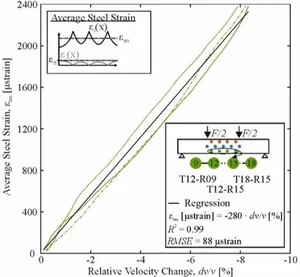Thermo-mechanical experiments of RC structures correlated to distributed coda signals
The subproject RUB2 is situated on the structural scale. The project aims at the field-wise processing and correlation of (thermo-)mechanical quantities such as deformations, stresses in concrete and steel, crack patterns and widths as well as temperatures, individually and in interaction with ultrasonic results. For this purpose, large-scale experiments are carried out.
Project description
Condition assessment, maintenance, strengthening and, if necessary, renewal of bridges and tunnels are core tasks in civil engineering. Infrastructure forms the economic backbone of Germany and the world and ensures prosperity and growth. Its importance requires prudent and far-sighted action. The overall objective of RUB 2 is to enable the application of the non-destructive Coda technique to reinforced concrete structures such as bridges and tunnels.
In order to gradually extend the application of the Coda technique for damage detection and assessment to realistic cases of non-destructive testing in the monitoring practice of large-scale structures, 5 work packages are planned in the second project funding period: First, pre-stressing is included to give a decisive edge to pressure-induced versus tension-induced changes and to measure positive and negative strains that show a direct correlation with coda properties. Second, the influence of complex geometries and loss of direct line-of-sight between ultrasonic transducers, as well as damaged surfaces that are imitated by roughness, will be quantified in the coda. Spatial maps of damage probability obtained from the correlation of relative coda velocity change and strains will allow generalization and transfer findings to arbitrary structures. These components are brought together in a large-scale demonstrator so that tendon failures not visible from the outside are successfully detected and localized. The practical applicability and performance of such code-based monitoring will be evaluated on the reference structures "Gänstorbrücke" in Ulm and a subway station in Munich.
Previous Results
During the first funding phase, reinforced concrete beams were investigated in 4-point bending tests in non-cracked and cracked conditions with and without imposed stationary temperature fields. Ambient and structural humidity were measured. In addition to ultrasonic transducers and conventional techniques such as strain gauges, linear deformation transducers and thermocouples, fiber optic sensors (FOS), digital image correlation (DIC), and a thermal imaging camera were also used. Multi-ring electrodes (MRE) were utilized for moisture control.
Strains and ultrasonic signals were measured between all transmitters and receivers at each level. Coda wave interferometry (CWI) evaluates the ultrasonic measurements via the correlation coefficient (CC) and relative velocity change (dv/v). In the bending tests, tensile-induced stresses dominated the measured ultrasonic results, so a direct correlation to concrete strains is not possible. A comparison of the ultrasonic and strain results is nevertheless possible via the field-wise processing as attribute maps, which are compared with strain fields measured via DIC. For this purpose, the results of each sensor pair are discretely assigned to the center between the transmitter and receiver. In this way, compression and tension regions can be qualitatively identified. A steep drop of dv/v in the direction of the pressed edge additionally indicates the crack depth.
Similarities of the courses of dv/v and the mean strain of a moment-curvature relationship are striking. The quasi-continuous recording of the strain with FOS provides the mean strain of the reinforcing steel, which is correlated with dv/v. The coefficient of determination R² and the root mean square error (RMSE) demonstrate the high quality. Inversion allows inferring the load level and the steel strain in the crack via dv/v. From this, it is concluded that reinforced concrete structures subjected to mechanical loads can be well monitored far beyond the range of small structural changes deep into state II. Therefore ultrasonic signal data with stepwise CWI are evaluated and correlated with the strains of the steel reinforcement.


